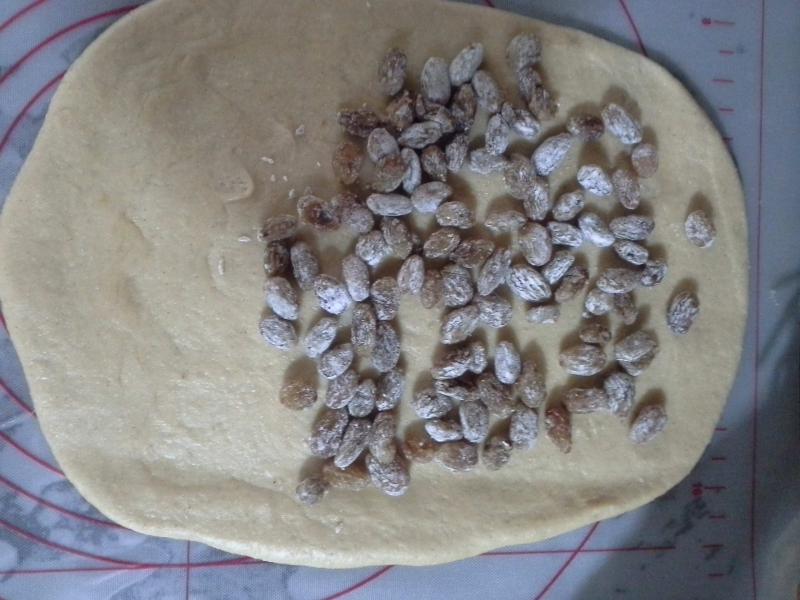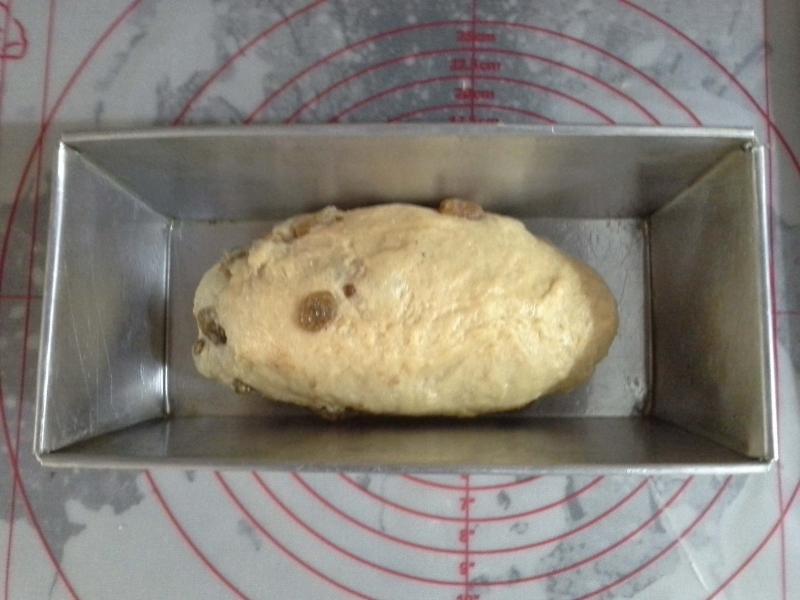
Cramique
Cramique (Fr) or Kramiek (Dutch) is the name given to a type of rich, sweet breakfast bread with raisins such as sold in traditional bakeries in Belgium. The following is the traditional recipe such as it’s been used for the past 100 years or so. Some variants exist and I’ll briefly mention those at the end of the recipe.
Typically this is eaten freshly baked on Sunday mornings while having a leisurely breakfast with the family. It’s tasty to eat ‘as it is’ with some butter but favourite toppings include high quality chocolate paste, or with speculoos(paste), served with coffee or strong chocolate milk. It’s also delicious when toasted and paired with onion confit and pate or pan-seared foie gras, accompanied by a glass of well developed, aromatic sweet white Bordeaux wine such as a Sauternes or (cheaper) Montbazillac.
Formula (yields one large loaf)
- White bread flour, 430 grams (strong bread flour is ok but a 50-50 mix with all purpose flour also works well)
- Milk, room temperature, 220 grams
- Butter, unsalted, 85 grams
- 1 egg, loosely beaten,(about) 55 grams
- Fine granulated white sugar, 45 grams
- Salt, 5 grams
- Raisins, 250 grams
- Fresh yeast, 25 grams or bread machine yeast, 9 grams
- Small quantity of egg/milk mixture, for glazing the loaf
Remarks
- You can use white bread flour or a 50-50 mix of strong bread flour and all purpose flour. In bakeries 100% white bread flour is typically used because it results in a stronger, chewier crumb that's easier to cut and transport. If you like a more delicate texture that's perfect for immediate consumption, go with the 50-50 mix (which is what I'd recommend ).
- Some bakers add a small quantity of natural vanilla extract (NOT essence) to the liquids
- In stead of fresh yeast you can use bread machine yeast, reducing to 8 grams and adding this to the solids
- The butter needs to be tender for easy incorporation so take it out of the fridge 15 minutes beforehand. Do not melt it and do not substitute it with shortening or oil, the taste and mouth feel are not the same.
- Raisins can be sultanas or any seedless raisin variety but typically not currants, which tend to be drier. They can be incorporated as such or first soaked for at least ½ hour, then patted dry with kitchen tissue paper and dusted with flour to dry the surface. If you soaked them and to avoid making an unsightly mess, roll out your dough into a rough rectangle, spread out raisins over the top 2/3rd, then fold bottom third toward the middle and top third down. Manipulate the dough gently so as to achieve a good distribution. Don’t skimp on the quantity.
Preparation
- Add yeast to milk and dissolve, add loosely beaten egg and sugar
- Put the solids (flour, salt, butter) in a bowl
- Add the liquids and mix well, let stand for 10 minutes
- Knead well for 10 minutes by hand or about 6 minutes with a processor and hook
- Cover with oiled cling film and let ferment in bulk for 30 minutes (31 centigrade) or until almost doubled
- Toward the end of the bulk fermentation, add raisins and incorporate so as to distribute them evenly. It’s important not to add them earlier and to knead gently or they’ll turn to mush, certainly when soaked
- Flatten, fold and shape (boule for freestyle loaf), place on silicone baking mat or in a greased baking tin
- Cover and let rise for about 45 minutes in a warm (30 centigrade) room or until almost doubled
- Apply egg wash or milk
- Bake for about 40 minutes in the middle of a 190 centigrade oven, using conventional heat
- Remove when top crust is dark brown and it sounds hollow when tapped, it should effortlessly drop out of the tin
- Place on a wire rack and allow to cool
Variations
- Together with the raisins, 100 grams of pearl (P4) sugar can be added, it’s no traditional cramique anymore but some people like this, personally I feel it’s a bit over the top
- Raisins can be soaked in water or in rum to which 2 grams of speculoos spices or powdered cinnamon have been added, then patted dry, lightly floured and incorporated
- In the city of Liege, pearl sugar is added and the dough is placed in a round pie baking tin that has been lined with sweet pie dough.
Nutrition
The recipe as stated above will yield a dough mass of approximately 1150 grams.
After baking and cooling this will result in a loaf of approximately 930 grams, containing 3322 kCal or 357 kCal/100 grams approximately. One portion size would be 3 slices or approximately 100 grams. This represents about 18% of the average male's daily calorie needs. Of the calories, 25% are from fat.
Needless to say, this is not a lean bread but if you limit yourself to a normal portion on a Sunday morning it shouldn't be an issue.
Pictures
Below are some pictures. Note that I only baked half a quantity due to insufficient raisins on hand. Also, I did not let the dough bulk ferment until doubled; this has to do with local conditions (kitchen temperature of minimum 33 centigrade over which I don't have control). These same conditions make it necessary to reduce the yeast quantity. If you're baking under normal temperature conditions, do as I say in the recipe, not as I do in practice ;-) The pictures were shot using my phone under cold TL-lighting, in reality the colour of the finished product is more yellowish.
The dough immediately after mixing

After a 30 minute bulk fermentation

Incorporating the raisins

Placed in baking tin

Baked

Cut and ready to eat

- Xenophon's Blog
- Log in or register to post comments
Very nice bread. Must taste great s toasted with some cream cheese.
Thanks for sharing.
Ian
Do you ever include cinnamon in the bread?
Paul
Toasted with butter and some marmalade sounds perfect. Well done and thanks for the recipe.
Happy baking
Thanks everyone! And bon appétit!
@Paul: Contrary to e.g. in the U.S., cinnamon as such is rarely if ever added to breads in Belgium; I actually only know of one traditional bread that has it as a dough ingredient (though that's a VERY traditional one, going back to the 14th century). A matter of taste of course, for the cramique I wouldn't add it to the dough as it's a bread that relies on the subtly brioche-like butter taste coupled with the very soft crumb and the taste/texture of the raisins; cinnamon might overpower that combo a bit. But it's all a matter of taste.